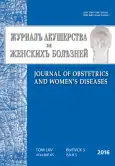Experience of application anti adgesivebarrier in the treatment of patients with Asherman’s syndrome
- 作者: Makarenko T.A1, Nikiforova D.E1, Ul’yanova I.O1
-
隶属关系:
- Krasnoyarsk state medical University named after Professor V.F. Voyno-Yasenetsky
- 期: 卷 65, 编号 5 (2016)
- 页面: 29-32
- 栏目: Articles
- URL: https://journals.rcsi.science/jowd/article/view/5806
- DOI: https://doi.org/10.17816/JOWD65529-32
- ID: 5806
如何引用文章
全文:
详细
Relevance. Asherman’s syndrome is one of the most difficult problems in gynecologic practice, because in addition to complex clinical picture, which includes secondary amenorrhea and infertility is a significant difficulty in diagnosis and treatment. The purpose was to improve the results of treatment of Аsherman’s syndrome after conducting hysteroresectoscope adhesiolysis using anti adhesive barrier “Antiadgezin”.
Materials and methods. The study included 36 patients with peritoneal process in the uterus of varying severity. Group I consisted of 20 women who are in the postoperative period in the uterine cavity was entered “Antiadgezin”, group II — 16 women with similar pathology without introducing anti adgesive barriers.
Results. All women 3 months after adhesiolysis was performed a control hysteroscopy. The presence of adhesions was diagnosed in 2 (10%) patients in the first group, while adhesions were isolated delicate and easily destroyed by the sheath of a hysteroscope. In group II adhesions had recurrences in 5 (31,3%) patients (p = 0,038), and one patient was visualized “tunnel” — uterus, which is extremely unfavorable course of disease.
Conclusion. Treatment of Asherman’s syndrome, as extreme degree of intrauterine adhesions, requires a comprehensive approach, which is based on prevention of recurrence of the formation of adhesions after surgical interventions. Research on application anti adgesivebarriers will continue, as intrauterine their use on the example of antiadgezin showed good results.
作者简介
Tatyana Makarenko
Krasnoyarsk state medical University named after Professor V.F. Voyno-Yasenetsky
编辑信件的主要联系方式.
Email: makarenko7777@yandex.ru
MD, docent, head of Department of operative gynecology of postgraduate studies 俄罗斯联邦
Daria Nikiforova
Krasnoyarsk state medical University named after Professor V.F. Voyno-Yasenetsky
Email: dashsemch@mail.ru
postgraduate student of operative gynecology of postgraduate studies 俄罗斯联邦
Inga Ul’yanova
Krasnoyarsk state medical University named after Professor V.F. Voyno-Yasenetsky
Email: inga_ulyanova@mail.ru
PhD, associate docent in the Department of operative gynecology of postgraduate studies 俄罗斯联邦
参考
- March CM. Management of Asherman’s syndrome. Reprod Biomed Online. 2011;23(1):63-76. doi: 10.1016/j.rbmo.2010.11.018.
- Asherman JG. Traumatic intra-uterine adhesions. J Obstet Gynaecol Br Empire. 1950;57(6):892-6.
- Сухих Г.Т., Назаренко Т.А. Бесплодный брак. Современные подходы к диагностике и лечению: руководство. — М.: ГЭОТАР-Медиа, 2010. [Suhih GT, Nazarenko TA. Besplodnyj brak. Sovremennye podhody k diagnostike i lecheniju. Moscow: GJeOTAR-Media; 2010. (In Russ.)]
- Daaloul W, Ouerdiane N, Masmoudi A, et al. Epidemiological profile, etiological diagnosis and prognosis of uterine synechias: report of 86 cases. Tunis Med. 2012;90(4):306-10.
- Takai IU, Kwayabura AS, Ugwa EA, et al. A 10-year Review of the Clinical Presentation and Treatment Outcome of Asherman’s Syndrome at a Center with Limited Resources. Ann Med Health Sci Res. 2015 Nov-Dec;5(6):442-6. doi: 10.4103/2141-9248.177984.
- Тарасенко Ю.Н., Салов И.А., Ташухожаева Д.Т., Маршалов Д.В. Внутриматочные синехии: современный взгляд на проблему // Современные проблемы науки и образования. — 2013. — № 4. — С. 145–157. [Tarasenko YuN, Salov IA, Tashu¬khozhaeva DT, Marshalov DV. Intrauteri adhesions: modern look at the problem. Modern problems of science and education. 2013(4):145-157. (In Russ.)]
- Петров Ю.А. Хронический эндометрит в репродуктивном возрасте: этиология, патогенез, диагностика, лечение и профилактика: автореф. дис. … д-ра мед. наук. — M., 2012. [Petrov JuA. Hronicheskij jendometrit v reproduktivnom vozraste: jetiologija, patogenez, diagnostika, lechenie i profilaktika. [dissertation]. Moscow; 2012. (In Russ.)]
- Panayotidis C, Weyers S. Intrauterine adhesions (IUA): has there been progress in understanding and treatment over the last 20 years? Gynecological Surgery. 2009;6(3):197-211.
- Борцвадзе Ш.Н., Ажибладзе Т.А., Ишенко А.И. Значение офисной гистероскопии в диагностике маточного фактора бесплодия и лечении таких больных // Российский вестник акушера-гинеколога. — 2012. — T. 12. — № 5. — С. 53–56. [Borcvadze ShN, Azhibladze TA, Ishenko AI. Value of office hysteroscopy in the diagnosis of maternal factor infertility and in the treatment of these patients. Rossijskij vestnik akushera-ginekologa. 2012;12(5):53-56. (In Russ.)]
- Попов А.А., Мачанските О.В., Головина Е.Н. Офисная гистероскопия в диагностике и лечении женского бесплодия // Проблемы репродукции. — 2011. — Т. 17. — № 2. — C. 43–45. [Popov AA, Machanskite OV, Golovina EN. Office hysteroscopy in the diagnosis and treatment of female infertility. Problemy reprodukcii. 2011;17(2):43-5. (In Russ.)]
- Ташухожаева Д.Т., Салов И.А., Маршалов Д.В., Тарасенко Ю.Н. Метод профилактики внутриматочных синехий после самопроизвольного аборта // Современные проблемы науки и образования. — 2013. — № 4. — C. 146–154. [Tashuhozhaeva DT, Salov IA, Marshalov DV, Tarasenko JuN. The method of prevention of intrauterine adhesions after a spontaneus abortion. Modern problems of science and education. 2013;(4):146-54. (In Russ.)]
- Kim T, Ahn KH, Choi DS. A randomized, multi-center, clinical trial to assess the efficacy and safety of alginate carboxymethylcellulose hyaluronic acid compared to carboxymethylcellulose hyaluronic acid to prevent postoperative intrauterine adhesion. J Minim Invasive Gynecol. 2012;19(6):731-6.
- Di Spiezio Sardo A, Spinelli M, Bramante S, et al. Efficacy of a polyethylene oxide-sodium carboxymethylcellulose gel in prevention of intrauterine adhesions after hysteroscopic surgery. J Minim Invasive Gynecol. 2011;18(4):462-9. doi: 10.1016/j.jmig.2011.04.007.
- Кузнецова И.В., Землина Н.С., Рашидов Т.Н., и др. Проблема тонкого эндометрия и возможные пути ее решения // Эффективная фармакотерапия. Акушерство и гинекология. — 2015. — Т. 5. — № 1. — C. 42–49. [Kuznecova IV, Zemlina NS, Rashidov TN, et al. Problem of Thin Endometrium and its Possible Solutions. Jeffektivnaja farmakoterapija. Akusherstvo i ginekologija. 2015;5(1):42-49. (In Russ.)]
- Силантьева Е.С. Физические методы структурно-функционального ремоделирования эндометрия у женщин с нарушением репродуктивной функции: автореф. дис. … канд. мед. наук. — M., 2008. [Silant’eva ES. Fizicheskie metody strukturno-funkcional’nogo remodelirovanija jendometrija u zhenshhin s narusheniem reproduktivnoj funkcii. [dissertation]. Moscow; 2008. (In Russ.)]
- Lebovitz O, Orvieto R. Treating patients with “thin” endometrium — an ongoing challenge. Gynecol Endocrinol. 2014;30(6):409-14. doi: 10.3109/09513590.2014.906571.
- Nagori CB, Panchal SY, Patel H. Endometrial regeneration using autologous adult stem cells followed by conception by in vitro fertilization in a patient of severe Asherman’s syndrome. J Hum Reprod Sci. 2011;4(1):43-8. doi: 10.4103/0974-1208.82360.
补充文件







